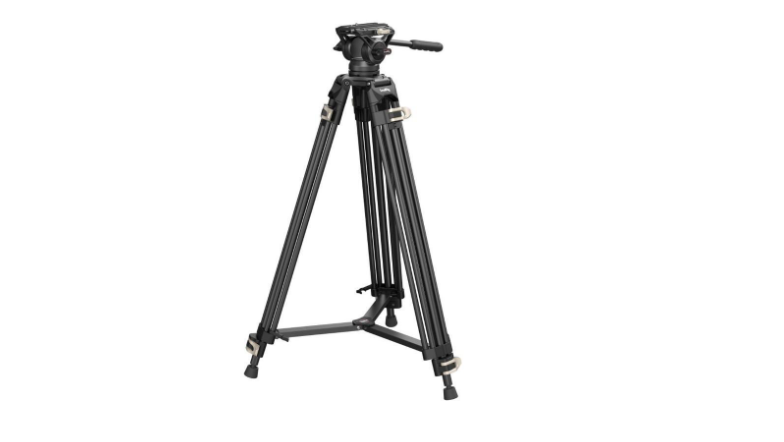Have you ever wondered why a fluid head tripod is more sophisticated than other tripods? A fluid head tripod is a specialized camera accessory that consists of different mechanisms that helps reduce jitters to the barest minimum when moving the gimbal and also facilitate load-bearing performance.
A good fluid head tripod delivers buttery-smooth movement when shooting. Irrespective of which motion (either pan or tilt), a well-made fluid head tripod would give you the best of both movements and help you avoid shaky footage.

1. Tilt Counterbalance
The first question is how the tripod operates when tilting your camera. For example, a fluid head will provide smoother shots for instances that require tilting. If you were tilting with a cheaper video head that’s void of a fluid head, the tilt could cause the camera to move as there is no drag to slow down the movement or hold the tilt in position.
On the other hand, if you use a fluid head, the camera won’t move regardless of the angle you decide to shoot. This is because of the tilt drag counterbalance mechanism, which can maintain the fluid compression within the heavy-duty tripod head. It essentially stabilizes any movement to ensure you get a smooth shot.

2. Fluid Drag Panning
Imagine fluid drag as the special sauce within a fluid head tripod system. The fluid we are referring to is grease or oil material. Within the construction of the tripod head, you’ll find multiple disc plates. These plates move correspondingly together depending on the user’s drag setting. The grease or oil gets trapped within these plates, causing the panning to slow down or move more freely. So if you find your camera pan movements inconsistent in speed, you will need a fluid head.
3. Fluid Head Handle Length
Another thing that can cause an inconsistent pan is the length of the tripod head handle. The handle assists the operator with subtitle panning or tilt movements. The longer the handle is on a fluid head, the better, as panning will become less noticeable, especially at the start or the end of a camera movement.
4. Tension Control for Panning or Tilting
If you find movement is too loose, you may need to adjust the tension control for panning and tilting. It’s important to constantly adjust these settings in several scenarios, including balancing the fluid head tripod, the type of camera you plan to use, and the type of camera movement required.
If you fail to adjust these settings, you may find the tension too loose, which can cause unexpected camera movements. These two controls have a lot of effect on the smoothness of each camera movement. On the fluid head, you’ll notice a series of numbers. The higher the number, the greater the tension.
5. The Weight
The weight of the fluid head tripod depends on the size of the camcorder or rig you are planning to mount. Bigger cameras require larger fluid head tripods, and it is recommended to tighten the drag to have more controls.
Why Do You Need a Fluid Head Tripod?
Now we understand the mechanics of a fluid head tripod; the idea behind the fluid head tripod system becomes clearer to filmmakers. The biggest case point for a fluid head tripod is that it provides minimum jitter and maximum payload for filmmakers. In addition to this, compatibility is a huge deal. For instance, if you are moving from a gimbal or rig, you want to make sure the system you go for is compatible.
Another benefit is the adaptability of a fluid head tripod. Fluid head tripods are usually compatible with most camera setups.
Overcoming Challenges: What We Recommend
Using a fluid head tripod brings stability and balance to your footage while helping to minimize inconsistent tilts and pans that make footage unusable. If you are new or already adept in filmmaking, or documentary work, we recommend upgrading to a fluid head tripod, which is designed specifically to assist you in getting smooth panning shots.

One product we highly recommend is the SmallRig Heavy-Duty Fluid Head Tripod AD-01 (3751). This USD 159 kit is designed for medium to large camcorders and accepts DJI RS2 and Manfrotto plates, meaning you can easily interchange a gimbal and a tripod. If you switch between photography and clients wanting video, you’ll find flexibility with this setup. The fluid head can pan 360 degrees, and the tilt operates to a latitude between +90°/-75°.
Overall, we highly recommend this fluid head tripod for anyone entering the space and pros wanting a lightweight system that’s capable of holding up to 8kgs. When you purchase the SmallRig Heavy-Duty Fluid Head Tripod AD-01 (3751), you’ll get the following:
1 × Heavy-Duty Fluid Head Tripod AD-01
1 × Carrying Bag
1 × Manfrotto Quick Release Plate
1 × 1/4”-20 Screw
1 × 3/8 “-16 Screw
1 × User Manual
In summary, if you want to record a video, a fluid head tripod is something you need in your kit. Without a fluid head, any camera movement will be inconsistent in speed and flow. Look for a SmallRig heavy-duty fluid head tripod with fine control over the drag to ensure you gain the desired level of tension and movement. Once you’ve mastered the fluid head, you will be well on your way to recording professional-looking camera moves.
For more information, visit https://www.smallrig.com/.









